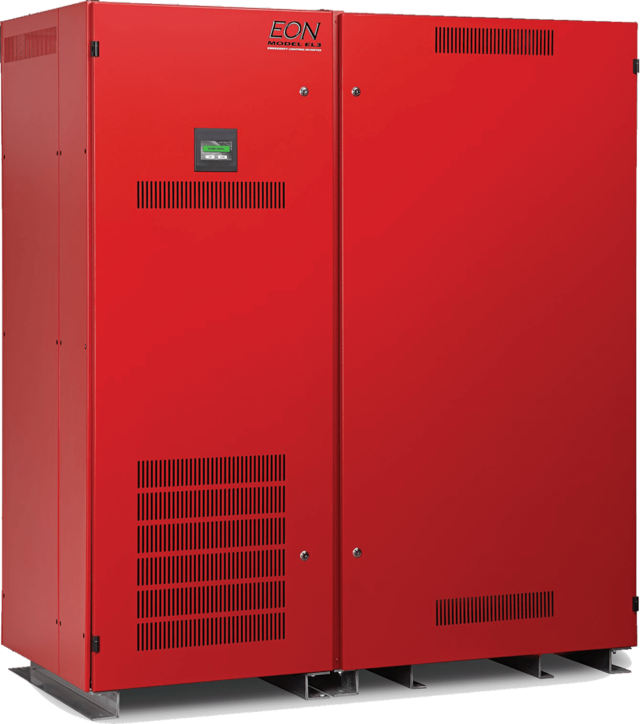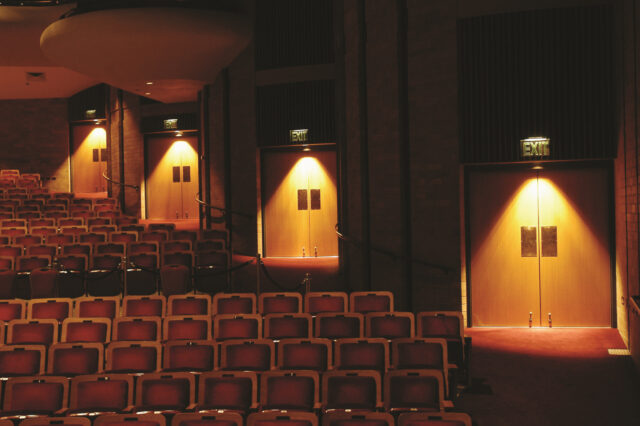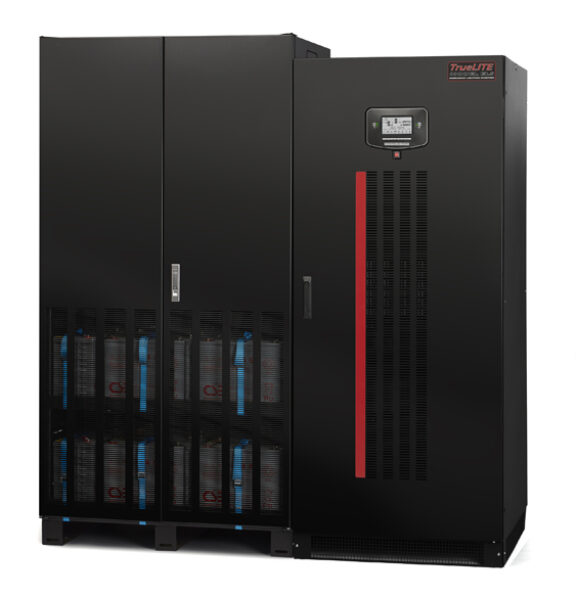Our team is here to support you and solve your power challenges. Connect with our responsive experts today to learn about our customized power solutions and products.
EON Model EL3 (10kW - 55kW) Three Phase
With expanded output ratings up through 55kW, the three phase EON Model EL3 centralized emergency lighting inverter offers the best reliability and performance for your egress lighting system!
Meeting stringent design and performance specifications, the self-diagnostic, self-testing EON is UL 924 listed as “Emergency Lighting Equipment” and “Auxiliary Lighting and Power Equipment,” as well as NFPA compliant as “Life Safety Equipment.” The EON meets NFPA 101, NFPA 111, NEC, and IBC requirements, and provides the industry’s most advanced life safety system testing available.
Whether fed from the AC power source or even while in battery mode, the EON has a peak overload capability of 1700% to accommodate inrush current from LED fixtures!
The EON model features one of the smallest three phase cabinet footprints in the industry! See how our 90-minute 33kW Inverter cabinet footprint compares to others.
Optional Seismic-Rated Models
Available Up to 33kW!
The EON has been shake-table tested and our 10kW – 33kW models are offered with an optional seismic rating. These models meet seismic standards which satisfy applicable portions of the California Building Code (CBC 2016) and the International Building Code (IBC 2015). The verification testing required is recognized and accepted throughout the U.S. and many other countries.


Applications
- Theaters/Concert Halls
- Auditoriums
- Worship Facilities
- Conference/Banquet Centers
- Shopping Malls
- Casinos
- Sports Facilities
- University Buildings
- Healthcare Facilities
- Correctional Facilities
- Subway/Train Stations
- Industrial Manufacturing
- Warehouses
Product Specifications
Features & Benefits
- Full compliance with NFPA 101, section 7.9.3.1.3 – computer-based, self-testing/self-diagnostic emergency lighting system with data-logging
- Standard Intellistat TS™ monitor – provides quick full-access to all inverter features, allows all programming to be done directly from touchscreen display, and provides system diagnostics and testing
- Reliability, plus compatibility – provides reliable, regulated voltage during normal and emergency power modes; compatible with all lighting fixture types, including LED
- Small overall footprint – inverter and battery “front access” cabinets are thoughtfully designed to be physically smaller than comparable three phase emergency lighting products
- Easy installation and low cost-of-ownership – 10kW to 33kW models require only (1) battery cabinet for 90 minutes runtime, and 40kW to 55kW models require only (2) battery cabinets
- To facilitate installation and maintenance, only batteries with front access terminals are used
- Automatic static bypass on overload or fault
- Integral internal bypass includes a make-before-break switch with a secure push-to-turn function – provides an uninterrupted bypass of the inverter system
- Wrap-around maintenance bypass options that include a padlock attachment for lockout/tagout purposes during maintenance
- LSI input / output breakers are standard or optional, model-dependent
- Optional normally off bus – provides standby power to “normally off” emergency lights when utility power is lost or is inadequate
- Optional front-access, side-mounted output distribution cabinet with circuit breaker options
- Optional network communications available via the Intellistat TS – provides remote monitoring of inverter status, test results, alarms, and electrical measurements via BACnet, Ethernet, MODBUS TCP, or MODBUS RS485
Three Phase Sizes
- 10kW, 13kW, 14kW, 15kW, 16kW, 17kW, 20kW, 22kW, 24kW, 26kW, 28kW, 30kW, 32kW, 33kW, 40kW, 45kW, 50kW, and 55kW.
- (Optional 52kW rating is available with 30-minute runtime only, C-UL listed.)
Performance Specs
- Input and Output Nominal Voltage: 208/120V, 480/277V, or 600/347V Wye
- Input Operating Voltage Range: +10%, -15% at full load
- Input Frequency: 60 Hz, ± 2.5% (50 Hz models available)
- Input Power Factor Correction: > .98 pF typical, at full load
- Output Voltage Regulation: ± 3% from nominal, typical
- Output Frequency: ± 0.5% while in battery operation mode
- Output Voltage Distortion: Typically 3% output THD with linear load
- Overload: Up to 110% for 2 minutes, 125% for 30 seconds, 150% for 10 seconds, and 400% for 4 cycles (without use of static bypass)
- LED Inrush Rating: Peak overload capability of 1700% to accommodate inrush current from LED fixtures (without the use of static bypass)
- Efficiency: 90% typical
- Operating Temperature: 20º to 35º C for UL 924 Listed models and C-UL Listed models to CSA C22.2 No. 141-15. UL testing performed at 40º C under full load and at low line input voltage
- Operating Temperature: 20º (10° optional) to 40º C for C-UL Listed models to CSA C22.2 No. 141-10
- Optimum Battery Performance and Life: 25º C for both UL and C-UL Listed models
- Battery Time: UL 924 Listed 90 minutes at full-rated kW output, or with optional runtimes from 15 minutes to 4 hours. C-UL Listed 30 minute runtime to CSA C22.2 No. 141-10; 141-15
Frequently Asked Questions
What are centralized lighting inverters and why use them?
A centralized lighting inverter is an electronic system that converts DC battery power to standard AC voltages to provide back-up for emergency lighting systems during a power outage. Centralized lighting inverters provide a single point source of power for all emergency lighting and exit signs. In addition, a centralized lighting inverter can automatically perform monthly and annual NFPA-compliant testing, log test results with a time and date stamp, and enable all maintenance to be performed from a single location.
Can all inverter systems handle the high inrush current associated with energizing LED fixtures/drivers?
Other manufacturers’ products may shut down if the high inrush current exceeds the inverter’s overload rating, especially the “on battery” overload rating. To combat this problem, most manufacturers OVERSIZE their inverter product . . . some by 35% or more!rnrnThis is not the case with the EON Model EL3! We’ve studied a number of sites that use LED fixtures for emergency egress lighting. Load profiles and inrush current data were captured and used to establish our lighting inverters’ overload ratings. Whether fed from the AC power source or even while in battery mode, our inverters have a high peak overload capability to accommodate the inrush current from LED fixtures/drivers.
Is the EON Model EL3 NFPA 101 compliant?
YES! The EON is UL 924 listed under Emergency Lighting and Power Equipment, in accordance with the ANSI/NFPA 101 Life Safety Code, Article 700 of the ANSI/NFPA 70 National Electric Code, and the International Building Code (IBC).
Does the EON Model EL3 automatically perform testing according to NFPA 101?
YES! The EON meets the NFPA 101 definition of a computer-based, self-testing/self-diagnostic emergency lighting system with data-logging (NFPA 7.9.3.1.3). Both periodic and annual tests are performed automatically, and the results are logged with a date and time stamp. Both alarm and test logs provide a history of events and the ability to generate an NFPA-compliant report.
How is the EON Model EL3 different from other lighting inverters with automatic testing?
BIG difference! The EON’s “Egress Lighting Integrity Test” provides the industry’s most advanced life safety system test available. To satisfy NFPA-mandated periodic and annual requirements, the EON’s Intellistat TS monitor automatically initiates the testing of all life safety circuits, regardless of egress lighting design (“always on” or “normally off”). The Intellistat TS then compares power consumption during the test period with user-defined load capacity, analyzes the data, and advises if service is required.
When automatically performing NFPA-mandated tests, can the EON Model EL3 energize emergency lighting circuits that are normally off, or dimmed/turned off, via a local control device?
YES! During these NFPA-mandated tests, an optional “test activated” contact may be used to activate one or more remotely installed ZoneSaver-2 emergency lighting control units. When activated, the ZoneSaver-2 will feed emergency power to egress lighting that is normally off, or dimmed/turned off via a local control device. This option allows for automatic testing of the locally controlled life safety circuit and the ZoneSaver-2 control unit. Consult factory for product and application details.
Is the EON Model EL3 easy to install?
YES! The EON’s 90-minute configuration requires only one battery cabinet of up to 33kW and only two battery cabinets of 40kW – 55kW. Only batteries with front access terminals are used. Both of these features make installation easy and less time consuming – installation is straightforward and DC connections are easily made!
Does the EON Model EL3 provide remote monitoring?
YES! Option one is isolated, potential free (Form C) Status/Alarm Relay Contacts, accessible via a terminal strip for a hardwired connection to building monitoring and security systems. Option two is network communications. The EON’s Intellistat TS monitor is capable of communicating system status, test results, alarms, and electrical measurements via BACnet/IP or BACnet MS/TP, Ethernet TCP/IP, MODBUS TCP, or MODBUS RS485.
Can the EON Model EL3 be provided with a distribution cabinet containing output circuit breakers?
YES – Provided in a side-mounted 14” wide (10kW – 33kW) or 29” wide (40kW – 55kW), front access output distribution cabinet! For 10kW – 33kW models, the distribution cabinet includes 12 pole positions per phase to accommodate 1, 2, and 3 pole circuit breakers fed from an inverter system output of 208/120 VAC or 248/277 VAC. For 40kW – 55kW models, the distribution cabinet can be provided with up to four (4) factory-installed 3-pole output circuit breakers. Within either distribution cabinet, the circuit breakers are located behind a secured, lockable, hinged door; and can be factory-wired to the “Normally On” bus and/or “Normally Off” bus in any combination specified.
Can the EON Model EL3’s output branch breakers be monitored?
YES! Monitored output circuit breakers are available. If a circuit breaker is open, the Intellistat TS™ monitor sounds an alarm. Optional alarm relay contacts are also available.
Is it important that lighting inverter systems provide a regulated output to emergency fixtures?
The answer is YES for many reasons. Here are some of them. A regulated voltage source: 1) Provides stable voltage to sensitive light fixtures and LED drivers. 2) Minimizes voltage drops associated with longer wire runs. 3) Results in less-frequent replacement of ballasts, LED drivers, and lamps in particular! 4) Facility egress lumens are maintained 100% (will not diminish) over the full 90 minutes of emergency power.
Is the EON Model EL3 a fast transfer lighting inverter system?
The answer is NO…it’s better! Fast transfer systems do experience a break in power. The EON has an online, double conversion, topology which means that the inverter is always on. If there is a loss of power, the inverter will draw energy from the batteries instead of the normal AC input source, with no break in the power. Thus, the EON exceeds the performance of all fast transfer systems.
Does a “fast-transfer” lighting inverter provide clean, stable power to LED fixtures when operating from the AC input power source?
The answer is NO. Fast-transfer inverter systems feed the AC input power source directly to the LED fixtures. The quality of the power feeding the LED fixtures depends on the quality of the AC power source. If voltage sags, surges and transients are present…the LED fixtures will be affected, often causing premature failure.
Does the EON Model EL3 have a transfer time, and if so, is it important?
The EON DOES NOT have a transfer time because of its online, double conversion topology. Transfer time is the time it takes to recognize and deliver emergency power. The transfer time of any standby or “fast transfer” inverter results in a momentary interruption or break in output voltage. For many applications, this is simply not desirable. A zero transfer time insures that there is no interruption of power to the emergency lighting fixtures. Lighting control systems and alarm circuits may also need a no break type system because of the circuit power requirements.
Is the EON Model EL3 capable of operating both normally off and normally on lighting fixtures?
YES! The EON has a normally on output bus and an optional normally off output bus. Both outputs may be configured with branch circuit breakers, allowing for an easy and less expensive installation.
When supplying power to normally off emergency lights, are there any application issues to consider?
YES. Adjustable transfer on delay and transfer off delay settings are often used. The transfer off delay in particular is often set at 10 to 15 minutes, which allows plenty of time for HID fixtures (if used in the area) to regain their full illumination. These adjustable time delays are standard when the EON’s normally off bus is selected.


